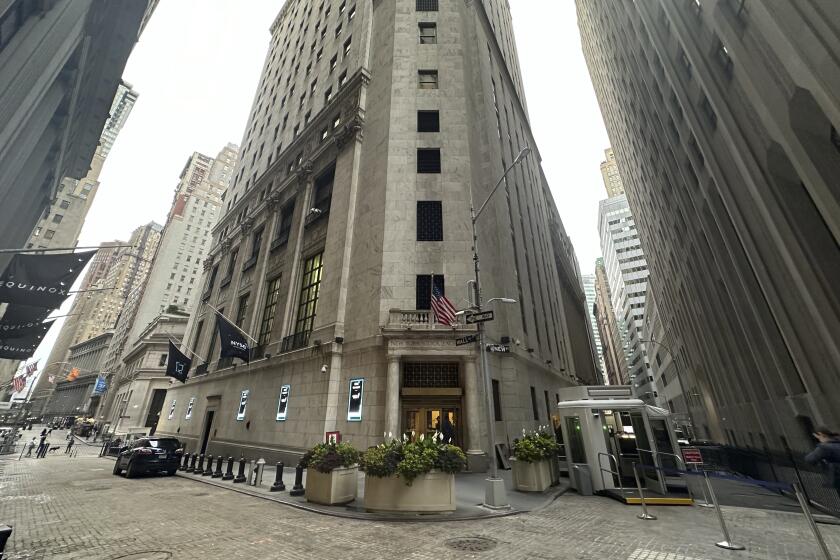REBOUND ON WALL STREET : Analysis : Thunder of a New Breed of Bulls
This time it’s different. Investors bulled stock prices to a big rebound Monday, demonstrating great confidence in the U.S. economy and their own judgment. Their action was in marked contrast to two years ago, when the market crashed and investors, fearing an imminent recession, fled from stocks.
Now, visible evidence of a slowing economy did not deter them. “Considering that corporate earnings are falling, not rising, it’s amazing how easy it was for the market to bounce back,” said Charles Clough, chief investment strategist for Merrill Lynch Capital Markets. His own forecasts for company earnings notwithstanding, Clough recommended Monday that his firm’s professional investor clients increase their holdings of common stocks and reduce holdings of bonds.
In doing so, he followed a thundering herd of brokerage houses making similar recommendations. Goldman, Sachs & Co., Shearson Lehman Hutton, Paine Webber and the research house Sanford C. Bernstein & Co., among others, advised customers to put more money in the stock market.
Evidently, they were preaching to the choir as many investors spent the weekend telling their brokers and even the Gallup Poll that they were in the mood to invest. The Gallup organization polled a few hundred of Fidelity Investments’ mutual fund customers and found almost all of them upbeat about the American economy and prepared to stay invested in stocks for the long term.
Individual brokers heard similar sentiments. “I came in Monday morning with buy orders,” said Walter Haddad, senior vice president of Paine Webber in Los Angeles. Haddad waited until a selling hangover from Friday cleared the market--during roughly the first hour of trading--and then went in buying. He was part of a nationwide rush to purchase stocks that drove trading volume to 416.29 million shares, the fourth largest ever.
Confident as they were about the economy’s underlying strength, investors favored basic industries. Shares of the chemical companies, Dow and Du Pont, each rose more than $3. General Electric was up more than $2, AT&T; was up more $3. Heavy machinery makers Caterpillar, Deere and Ingersoll Rand were up; the aluminum companies Alcan and Alcoa were up. Even the automobile makers, Ford, General Motors and Chrysler, were up, although the outlook for car sales this fall is not strong.
The over-the-counter market, where stocks of smaller companies are traded and individual investors outnumber big institutions, declined early Monday--a late reaction to Friday’s fall in the larger markets. But the OTC recovered later to post a small loss on the NASDAQ composite index.
In their optimism, investors were making up for a past mistake, explained investment managers. After the market’s 190-point plunge on Friday, investors recalled their fears of recession in October, 1987, and also remembered that those fears had been unwarranted--that in fact common stocks had outperformed certificates of deposits and other investments in the year following the crash. They were determined not to miss out this time.
To be sure, some investment experts questioned whether lightning would strike twice. Kenneth Fisher, a San Francisco investment manager, suggested that this is a time to be more cautious than enthusiastic about stock investments.
“There is weakness in all parts of the auto supply industry,” Fisher noted, as Detroit auto makers have scheduled relatively low production for the next few months. “And the trucking industry is already suffering hard times.” Nonetheless, investors boosted prices Monday for such auto suppliers as Genuine Parts and for the big trucking firm Consolidated Freightways.
Danger for Investors
In high technology also, there are signs the economy is slowing--from the owner of a small software company, who wonders why sales dried up in October, to giant IBM, which reported a 29% decline in third-quarter earnings on Monday. (IBM had forecast the decline weeks ago, and its stock had already fallen. Nonetheless, IBM dropped to a 52-week low of $97.75 a share early Monday before recovering to close at $103.)
The danger for investors, said Fisher, is that their enthusiasm for the economy’s long-term strength will blind them to its near-term weakness and they’ll fall into a “sucker’s trap”--buying stocks in a market rally that masks a general, long-term decline.
The public wasn’t listening to bearish advisers, however--or to bullish ones for that matter. They were listening to their own counsel, said Michael Hines, who samples investor psychology for Fidelity. “Ever since the 1987 crash, the public has been disregarding the major institutions and making up its own mind,” said Hines.
No institution had been able to predict the crash, they decided--and none had predicted Friday’s plunge either. So individual investors now rely on their own judgment.
As Monday’s rebound demonstrated, they are no longer easily frightened and, though the going might get rough for a while, they are in for the long haul. That’s why the number of individual investors, which fell to 33 million after the crash two years ago, has grown back to more than 50 million at present. The American public, in short, is bullish.
KEY MARKET INDICATORS
Stock Indexes Monday close Up/down % change Dow industrial index 2,657.38 +88.12 +3.43 Dow transportation index 1,304.23 -102.06 -7.26 Dow utilities index 214.73 +2.77 +1.31 NYSE composite 189.77 +4.21 +2.27 AMEX 376.41 -2.04 -0.54 NASDAQ composite 460.98 -6.31 -1.35 Standard & Poor’s 500 342.85 +9.23 +2.77 Wilshire 5,000 3,354.31 +58.64 -1.78
More to Read
Inside the business of entertainment
The Wide Shot brings you news, analysis and insights on everything from streaming wars to production — and what it all means for the future.
You may occasionally receive promotional content from the Los Angeles Times.










